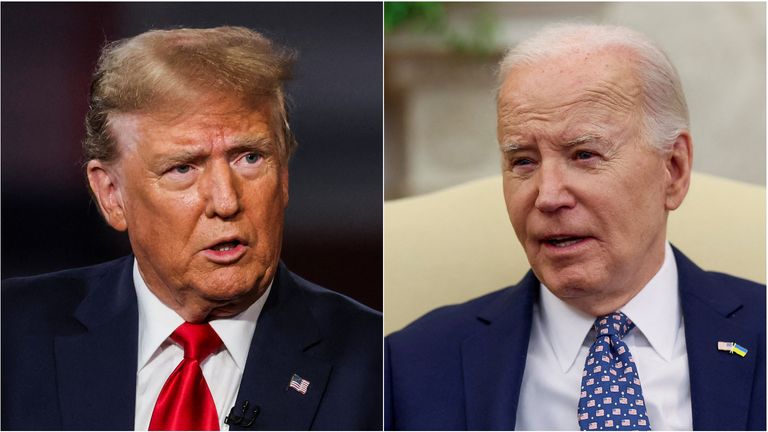If, as expected, the European Central Bank (ECB) cuts its main policy rate on Thursday it will be a hugely significant moment.
At a very basic level, the cut – the ECB is expected to trim its deposit rate from 4% to 3.75% – should benefit millions of households and businesses across the eurozone, who have never known interest rates this high since the single currency was born 25 years ago.
British tourists venturing to the usual summer hotspots should also benefit although it is fair to say the foreign exchange markets have been pricing in a rate cut for a while. The pound has risen by 1.5% against the euro since mid-April.
But the move will also be more significant in terms of what it says about central banks around the world.
At the beginning of the year, the US Federal Reserve was widely expected to be the first major central bank to cut interest rates.
That would have kept up a tradition that had been more or less in place since the Second World War in which the Fed always tended to cut rates before its global peers. The tradition was ended when, in 2011, the ECB cut interest rates in response to the eurozone sovereign debt crisis while the Fed kept its main policy rate, Fed Funds, unchanged.
There was a further break with tradition when, in 2013, the ECB began cutting interest rates again while the Fed left them unchanged.
However, those were not normal times. So this week’s move will be the first time in relatively normal circumstances since before the war in which the ECB (or the Bundesbank, the most important central bank in Europe prior to European monetary union) has cut before the Fed.
It is important to note at this point that the ECB is far from being the only central bank whose monetary policy is diverging away from that of the Fed. The Swiss National Bank and the Riksbank, Sweden’s central bank, have already cut interest rates this year and, at the time of writing, the Bank of Canada was also expected to cut interest rates later on Wednesday.
The Bank of England, too, is expected to begin cutting interest rates in August while the Fed, by contrast, is now not expected to begin cutting until the final three months of the year.
Apart from breaking with the long-term trend for normal economic times, it is also worth nothing that a rate cut from the ECB this week would be doubly unusual, since eurozone inflation remains comfortably above the bank’s 2% target rate. It will be a rate cut borne of concerns about weaknesses in the eurozone economy.
And divergence in monetary policy from the Federal Reserve does not come without risks for the ECB.
In particular there will be concerns about what an early ECB rate cut will mean for the exchange rate between the euro and the US dollar. All other things being equal, it should weaken the single currency, making the price of exports from the eurozone to the US more competitive.
However, that comes with risks, not least in terms of pushing up the cost of imports – particularly energy, which is priced in dollars, which could in turn push up inflation. A weaker euro would also carry risks in a US election year in which both Joe Biden, the president and Donald Trump, his challenger, will be seeking to out-bid each other with protectionist policies.
As Mohamed El-Erian, adviser to Allianz and Gramercy and one of the world’s most experienced investors, wrote in the Financial Times last week: “Too large and persistent a divergence in rates risks weakening European currencies beyond the point where possible competitive advantages compensate for the costs of higher imported inflation.
“In a US election year, this could also fan protectionist tendencies that, already, are on the cusp of intensifying. The two together would risk financial instability that would spill back to amplify economic concerns.”
For that reason, most market-watchers do not expect this divergence in monetary policy to extend too far.
Bruce Kasman, head of global economic research at investment banking giant JP Morgan, told clients recently in a webcast: “The broad point is that if we look at 2024…[there are] limited opportunities for central bank easing – there is just not enough in terms of the inflation decline to actually argue that central banks can act aggressively.
“There is an opportunity for divergence but the broad message is that, in a world in which growth is overall resilient and inflation is still drifting lower but at a pace that’s not really getting you back… to something that central banks are quite comfortable with, it’s leaving you with relatively limited room for easing overall.”
That view is shared by strategists at BlackRock, the world’s biggest asset manager, who told clients in a note this week: “Falling inflation and 18 months of weak economic activity make the case for the ECB to start cutting rates. But we don’t think it will cut far and fast.
“Likewise in the US, we see just one or two Fed cuts this year. This is not your typical rate cutting cycle.
“Investors may see opportunities in further policy divergence, but we think it will be temporary as both central banks ultimately keep rates high for longer.”
So the message for households and businesses in the eurozone is this – while your borrowing costs are about to come down, they may not come down as much as you would like them to.
That also applies to Britons hitting the sun-loungers in Spain, Greece and elsewhere this summer. Enjoy the fillip to your holiday pound while you can.



